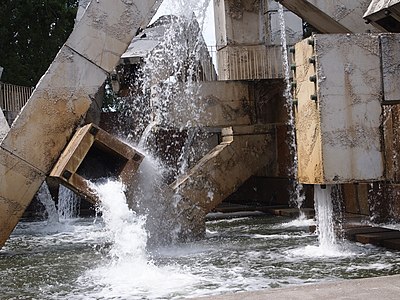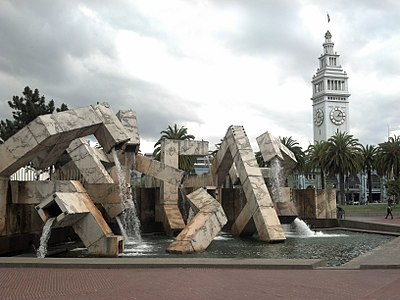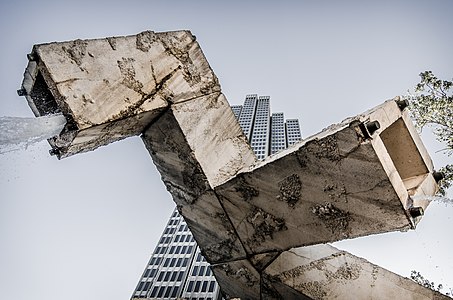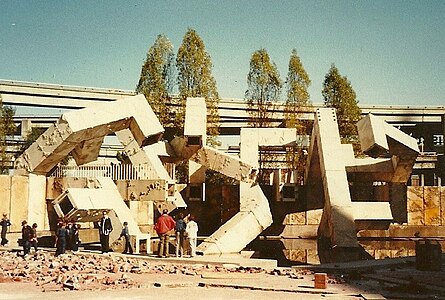Vaillancourt Fountain
| Vaillancourt Fountain | |
|---|---|
 | |
| Artist | Armand Vaillancourt |
| Completion date | April 21, 1971 |
| Type | Precast concrete |
| Dimensions | 12 m (40 ft) |
| Location | Embarcadero Plaza, San Francisco, California, United States |
| 37°47′43″N 122°23′43″W / 37.7954°N 122.3953°W | |
Vaillancourt Fountain, sometimes called Québec libre!, is a large fountain in Embarcadero Plaza in San Francisco, designed by the Québécois artist Armand Vaillancourt in collaboration with the plaza's landscape architect, Lawrence Halprin, and completed in 1971. It is about 40 feet (12 m) high and is constructed out of precast concrete square tubes. Long considered controversial because of its stark, modernist appearance, there have been several unsuccessful proposals to demolish the fountain over the years. It was the site of a free concert by U2 in 1987, when lead singer Bono spray painted graffiti on the fountain and was both praised and criticized for the action.
Location
[edit]
The fountain is in a highly visible spot on the downtown San Francisco waterfront, in Embarcadero Plaza (formerly Justin Herman Plaza), where Market Street meets The Embarcadero.[1] The Hyatt Regency Hotel is at the edge of the plaza, adjacent to the other four highrise towers of the Embarcadero Center. Across The Embarcadero is the Ferry Building, and the eastern end of the California Street cable car line is on the other side of the Hyatt Regency Hotel.

When Vaillancourt designed the fountain, the elevated Embarcadero Freeway was still in existence along the Embarcadero. The fountain was designed with the freeway environment in mind, but it was built to bring people to an expansive public space, as San Francisco Chronicle architecture critic John King called it "an act of defiant distraction until the freeway came down in 1991".[2][3]
Design and construction
[edit]Vaillancourt Fountain was a product of the redevelopment of San Francisco that took place in the 1950s and 1960s.[4] The Transamerica Pyramid was constructed from 1969-1972. BART was also being constructed; Embarcadero station would eventually open in 1976, three years after the other stations along Market.
Justin Herman, for whom the plaza was named, was a leading figure in this process and the executive director of the redevelopment agency in charge.[5] The plaza was one of several plazas proposed in the 1962 redevelopment analysis What to do About Market Street,[6] including Hallidie Plaza and United Nations Plaza, which were also completed in the mid-1970s. That 1962 analysis was written by planners Livingston and Blayney, landscape architect Lawrence Halprin, architects Rockrise & Watson, and Larry Smith Co. real estate consultants.
Plans for the plaza were drawn up by Mario Ciampi, John Savage Bolles, and Halprin. In August 1966 a committee consisting of those three, plus sculptor and Art Commission member Sally Hellyer, invited six sculptors to submit models for a loosely defined "monumental abstract sculpture".[7] By December five had responded: Jacques Overhoff, Reuben Nakian, Alicia Penalba, James Melchert, and Vaillancourt. The committee chose 38-year-old Vaillancourt but his second model, meant to show development of the design, did not even resemble the first model.[7] By November 1968 Hellyer had been replaced by Ruth Asawa, who rejected the design, saying in part, "I for one, am not willing to remain silent while we play the old game of the emperor's new clothes on the unsuspecting people of this city."[7][8] For his part, Halprin was quoted as saying that if the fountain didn't prove to be among the "great works of civic art ... I am going to slit my throat".[9]

The fountain is about 40 feet (12 m) high, weighs approximately 700 short tons (640 t), and is constructed out of precast concrete square tubes. The fountain is positioned in a pool shaped like an irregular pentagon, and is designed to pump up to 30,000 US gallons (110,000 L) of water per minute.[4]
The fountain looks unfinished, like concrete that has not been completely mixed. Up close, it is very rough and textured. There are several square pillars or cubed tubes that form a semi circle inside the pool. The natural[vague] colored pillars jut out and crisscross from the corner of the plaza "like the tentacles of some immense geometrical octopus. ... breaking open."[10] There are two bridges, or walkways with stairs, that allow the public to stand between the tubes and have a view overlooking the plaza and city. A series of platforms at pool level permit pedestrian entry into the fountain and behind the falling water.[11] The fountain and plaza are accessible to the public at all times and in all weather conditions. The fountain's budget was US $310,000. It was dedicated on April 22, 1971.[4] The Los Angeles Times reported that its cost was US $607,800.[12]
History
[edit]
Just before the dedication, the slogan "Quebec Libre" (a reference to the Quebec sovereignty movement) was painted on the fountain at night, and the graffiti was erased.[8] During the dedication, attended by Thomas Hoving, director of New York's Metropolitan Museum of Art, a rock band played, and Armand Vaillancourt himself painted "Quebec Libre" on the fountain in as many places as he could reach.[5][8] A redevelopment agency employee started to paint over the slogans during the ceremony, but Herman stopped him, saying it could be done later.[5] When asked about why he defaced his own fountain with graffiti he responded, "No, no. It's a joy to make a free statement. This fountain is dedicated to all freedom. Free Quebec! Free East Pakistan! Free Viet Nam! Free the whole world!"[8] Vaillancourt said his actions were "a powerful performance" intended to illustrate the notion of power to the people.[5] "Quebec Libre" has been an alternate name for the fountain since.[13]
Flamin' Groovies performed there, on the 19th September, 1979, and the concert was broadcast on KSAN (FM).
1987 U2 concert
[edit]
On the first leg of The Joshua Tree Tour by the rock band U2 in 1987, they performed concerts at the Cow Palace just south of San Francisco on April 24 and April 25, 1987. On the third leg of the tour, concerts had been announced for November 14 and 15, 1987, across the San Francisco Bay, at the Oakland Coliseum.
On the morning of November 11, 1987, local radio stations announced that U2 would hold a free-admission concert that day in Justin Herman Plaza, with the stage set up in front of the fountain. Within a few hours, a crowd estimated at 20,000 people gathered in the plaza.[14] The concert was jokingly called "Save the Yuppies", in reference to the 1987 stock market crash that had taken place three weeks earlier.[15]
The band closed their nine-song performance with their hit "Pride (In the Name of Love)".[16] During the instrumental portion in the middle of the song, Bono, lead singer of the band, climbed onto the sculpture and spray painted graffiti on it, reading "Rock N Roll Stops The Traffic".[16] Mayor Dianne Feinstein, who had been waging a citywide campaign against graffiti that had resulted in over 300 citations during the year, was angry and criticized Bono for defacing a San Francisco landmark.[17][18][19] She said, "I am disappointed that a rock star who is supposed to be a role model for young people chose to vandalize the work of another artist. The unfortunate incident marred an otherwise wonderful rock concert."[20] Bono was issued a citation for misdemeanor malicious mischief.[18] U2 manager Paul McGuinness said, "This is clearly not an act of vandalism. This act was clearly in the spirit of the artwork itself."[18] The numerous callers to Ronn Owens' radio talk show on KGO-AM were evenly split, with younger listeners defending the singer's action and older ones not.[17] Bono soon apologized,[17] saying "I really do regret it. It was dumb."[21] The singer explained that he thought that he was honoring the artist's work and that the artist had agreed, but later Bono realized that the city owned the fountain.[21] The group covered the cost of removal of the graffiti.[22]
Armand Vaillancourt flew from Quebec to California after the incident, and spoke in favor of Bono's actions at U2's Oakland performance several days later.[14] Vaillancourt said, "Good for him. I want to shake his hand. People get excited about such a little thing."[19] The sculptor spray-painted a slogan of his own on the band's stage, "Stop the Madness".[18]
The episode received further attention when it was featured in U2's 1988 documentary film Rattle and Hum.[16] There, footage of it was shown over, and interspersed with, the band's opening number, "All Along the Watchtower", a song by Bob Dylan that had been a big hit for Jimi Hendrix.[23] This has led some people to misidentify the song being played when the spray painting occurred.[14] The fountain and plaza are listed on one U2 fan site's list of recommended group-related places in the U.S. to visit.[23]
Demolition proposals
[edit]
Following the 1989 Loma Prieta earthquake, the elevated Embarcadero Freeway was so badly damaged that it was torn down, and was replaced by a boulevard at ground level. An architect hired by the city also proposed demolition of the fountain,[24] but no decision was made.
In 2004, San Francisco Supervisor Aaron Peskin renewed the call to demolish the fountain.[25] The water supply to the fountain had been turned off for several years, because of California's energy crisis of those years.[25] Armand Vaillancourt immediately pledged that he would "fight like a devil to preserve that work".[1] Debra Lahane, a member of the San Francisco Arts Commission, said that "it succeeds as a work of art if it provokes dialogue and discussion. Art that engages the public has had a measure of success."[1] Within a few months, the water was flowing again, and plans to tear down the fountain were abandoned.[26][27]
On and off
[edit]
At the fountain's opening in 1971, both the water flow and human participation were considered integral to the work. Alfred Frankenstein, writing for the San Francisco Chronicle, noted "the heart of the idea is the unique one of public entry into and intimate exploration of the fountain's innards; in this it is unique and decidedly a success. It is not a great work of sculpture, which is like observing that an automobile is not much of a success as a horse."[11]
The water was turned off at the fountain from 2001 until 2004, reopening on August 2, 2004. San Francisco estimated the cost of electricity was approximately US $200,000 per year to operate the fountain.[27] Peskin negotiated a public-private partnership where the city would pay for the operating costs (at a revised estimate of US $76,000 per year) and Boston Properties would pay for maintenance (estimated at US $20,000 per year).[28] The fountain was shut off again during the winter of 2007–08 starting in November 2007 so that skaters at the Justin Herman Plaza ice rink would not be splashed. It reopened on January 21, 2008.[29]
In reaction to the 2011–17 California drought, all of San Francisco's public fountains were shut off in order to conserve water. Vaillancourt Fountain was turned off in 2014 for the drought, but after that drought ended, the Recreation and Park department cited lack of funds to make repairs to the fountain as the reason it had not been reactivated.[30] The estimated cost of rehabilitation to allow water to flow again was approximately US $500,000.[31]
Charles Desmarais, the current[when?] art critic of the San Francisco Chronicle, echoed Frankenstein's comments from 1971, calling for the water to return in an August 2017 opinion article:
[T]he water is as essential to [Vaillancourt Fountain] as it was superfluous to [the nearby Mechanics Monument]. Vaillancourt is a sprawling, lifeless skeleton in its current dry state, with a chain-link fence blocking the two sets of stairs that once allowed people to peer down into the roiling maelstrom below. The chain of island-like steppingstones that made visitors feel they were walking on water is now a gantlet of precarious pedestals several feet above a rock-hard floor. The site is littered with trash. ...
It makes little sense to spend money to add even a single new object to our civic art collection if we allow the virtual eradication, through neglect and obliviousness to its original intention, of our city's most visible public work. We are the heirs to a memorial that, encountered as it was designed to be, animates a moment in art and history that cannot be re-created. If our city agencies can understand that, their priorities should be as clear as the waters of a healthy Vaillancourt Fountain.— Charles Desmarais, "Vaillancourt Fountain deserves respect — and water" August 5, 2017[11]
On August 15, 2017, water was restored to the fountain as a test run,[32] with the intention that it stay on until November, when the ice rink would reopen.[3] The water has been dyed with the 'Blue Lagoon' aquatic dye to control the growth of algae and bacteria. The nontoxic aquatic dye attenuates the penetration of light into the water, and tints the water blue.[33][34]

Critical reaction
[edit]The fountain has been considered controversial since its construction, and criticism of it has continued over the years.[1][35][36][26][37] Hoving, in his dedication speech, said of the fountain had some of the daring of Baroque sculpture and that "A work of art must be born in controversy."[5] Herman himself said it was "one of the greatest artistic achievements in North America."[5]
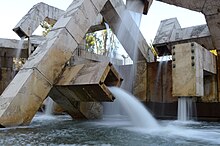
At the time of its dedication, the San Francisco chapter of the National Safety Council said that the fountain "may be a safety hazard".[12] Opponents of the work handed out leaflets at the dedication of the fountain describing it as a "loathsome monstrosity", a "howling obscenity", an "obscene practical joke", "idiotic rubble", and a "pestiferous eyesore".[5][36] Art critic Alfred Frankenstein of the San Francisco Chronicle responded that "its very outrageousness and extravagance are part of its challenge" and therefore, it "can't be all bad."[35] He added that the fountain was intended to be participated in rather than just observed.[5] An early comment by architecture critic Allan Temko, often repeated over the years, describes "technological excrescences" that had been "deposited by a giant concrete dog with square intestines".[35] Another pithy remark that gained press attention, from critic Lloyd Skinner, was that the fountain was "Stonehenge, unhinged, with plumbing troubles".[5]
Artists have been critical of the work as well. Sculptor Benny Bufano called it "a jumble of nothing", artist Willard Cox likened it to "dynamited debris", and sculptor Humphrey Diaquist said it had been created by "a figure of deranged talent".[5] Ruth Asawa noted in 1989 that "In the attempt to provide a disguise and diversion from the freeway, the goal of the fountain as a work of art was lost."[3]
The fountain has been called the "least revered modernist work of art" in San Francisco.[13] Due to its size, it has been said that it "dominates the landscape" of the north side of Justin Herman Plaza.[38] It has also been said that the design intent was "to mock and mirror the clumsy, double-decked roadway",[24] referring to the elevated Embarcadero Freeway which separated the fountain from the waterfront at the time of construction.
Charles Birnbaum, noted Halprin expert, stated the architect "always wanted people to interact with his water features" and that Justin Herman Plaza "was intended as a total environment, a space animated by people as well as water", so the fountain was designed to attract the public to an area otherwise cut off from the waterfront by the Embarcadero Freeway.[3]
Gallery
[edit]-
Detail showing one of the two aerial walkways (2011)
-
Dry pipes (2016)
-
Rear wall, with stair access to overlook (2010)
-
Inside the running fountain (2017)
-
Across The Embarcadero from the Ferry Building (2013)
-
Looking up at Four Embarcadero Center, rough texture retained (2012)
-
Hyatt Regency San Francisco (2007)
-
Reproduced in LEGO bricks at Miniland in Legoland California (2011)
-
Under renovation with Embarcadero Freeway in background (1980)
-
Pipe detail (dry fountain) (2014)
-
With tinted water (2017)
-
Slow exposure for water motion (2008)
-
Popular with children (2010)
-
Pedestrian access via water level platforms (2011)
-
Square platforms allow access inside the fountain (2017)
See also
[edit]References
[edit]- ^ a b c d Herel, Suzanne (March 17, 2004). "Justin Herman Plaza fountain's creator vows to fight Peskin's demolition proposal/ Some say piece looks awkward, draws transients". San Francisco Chronicle. Retrieved May 1, 2013.
- ^ King, John (1 June 2013). "Vaillancourt Fountain now stands alone". San Francisco Chronicle. Retrieved 11 September 2017.
- ^ a b c d King, John (15 August 2017). "Testing the waters for bringing the Vaillancourt Fountain back to life". San Francisco Chronicle. Retrieved 11 September 2017.(subscription required)
- ^ a b c Katz, Bernard S. (1989). Fountains of San Francisco. Nevada City, California: Lexikos Publishing Co. p. 23. ISBN 978-0-917583-19-3.
- ^ a b c d e f g h i j "$600,000 Fountain In California Dedicated". The Times-News. Hendersonville, North Carolina. United Press International. April 22, 1971. p. 8.
- ^ Halprin, Lawrence; Carter, Donald Ray; Rockrise, George T. (1962). "The Look of Market Street". What to Do About Market Street: A prospectus for a development program prepared for the Market Street Development Project, an associate of SPUR: The San Francisco Planning and Urban Renewal Association (Report). Livingston and Blayney, City and Regional Planners. pp. 23–34. Retrieved 30 August 2021.
- ^ a b c Frankenstein, Albert (12 January 1969). "The Great Controversy of the Plaza Fountain". San Francisco Examiner. Retrieved 30 August 2021.
- ^ a b c d "War Whoop for Freedom". Time. New York City. May 3, 1971. Archived from the original on March 8, 2008. Retrieved May 1, 2013.
- ^ King, John (October 27, 2009). "Lawrence Halprin - landscape architect - dies". San Francisco Chronicle. Retrieved May 4, 2013.
- ^ Thesis by John Grande, Concordia University, September 1997, Armand Vaillancourt's Social Sculpture
- ^ a b c Desmarais, Charles (5 August 2017). "Vaillancourt Fountain deserves respect — and water". San Francisco Chronicle. Retrieved 11 September 2017.(subscription required)
- ^ a b "Safety Group Hits Fountain". Los Angeles Times. May 3, 1971. Archived from the original on June 30, 2013. Retrieved May 1, 2013.
- ^ a b Rough Guides (2011). The Rough Guide to California. London: Penguin Books. ISBN 978-1-4053-8904-4.
- ^ a b c Kootnikoff, David (2010). U2: A Musical Biography. Santa Barbara, California: ABC-CLIO. p. 67. ISBN 978-0-313-36523-2.
- ^ "Spotlight: Music". Reading Eagle. November 12, 1987. p. 37.
- ^ a b c Selvin, Joel (1996). San Francisco: The Musical History Tour. San Francisco, California: Chronicle Books. p. 93. ISBN 0-8118-1007-0.
- ^ a b c Keane, Thomas G. (November 17, 1987). "U2 Star May Have to Scrub Buses". San Francisco Chronicle.
- ^ a b c d "Bono cited for malicious mischief". The Bryan Times. United Press International. November 17, 1987. p. 5.
- ^ a b KNT News Service (November 17, 1987). "Artist praises Bono's graffiti". Lewiston Journal. Lewiston, Maine. p. 10D. Retrieved May 1, 2013.
- ^ "Bono upsets Feinstein by spraying graffiti". Ocala Star-Banner. November 14, 1987. p. 2A.
- ^ a b "San Francisco Press Conference - 16 Nov. 87". Archived from the original on 2014-05-05. Retrieved 2013-09-05.
- ^ "Bono". People. December 28, 1987.
- ^ a b Guadiana, Jessica (July 28, 2011). "U2 Lists: Top 10 Places U2 Fans Must Visit In The USA". atU2.com. Retrieved May 8, 2013.
- ^ a b San Francisco Chronicle (October 18, 1992). "Debate spouts in San Francisco over controversial fountain Artwork impeding redesign of park". Dallas Morning News. Retrieved May 1, 2013.
- ^ a b Herel, Suzanne (March 16, 2004). "Councilman wants to dismantle fountain". San Francisco Chronicle. Retrieved April 30, 2013.
- ^ a b Friedman, Jan (2005). Eccentric California. Buckinghamshire, United Kingdom: Bradt Travel Guides. p. 38. ISBN 978-1-84162-126-5.
- ^ a b "Vaillancourt Fountain makes a splash again". San Francisco Chronicle. August 3, 2004. Retrieved April 30, 2013.
- ^ "San Francisco's Vaillancourt Fountain Starts Flowing Again" (Press release). City and County of San Francisco, Office of the Mayor. 2 August 2004. Archived from the original on 4 June 2013. Retrieved 13 September 2017.
- ^ Selna, Robert (16 January 2008). "San Francisco: Bone-dry fountain will be flowing again soon". San Francisco Chronicle. Retrieved 11 September 2017.
- ^ Klemm, Jürgen (1 May 2017). "Hey Area: Why is San Francisco's Vaillancourt Fountain dry?". KALW. Retrieved 11 September 2017.
- ^ Sisto, Carrie (9 August 2017). "Restoring Vaillancourt Fountain Would Cost $500K Or More". Hoodline. Retrieved 11 September 2017.
- ^ Keeling, Brock (15 August 2017). "Breaking: Vaillancourt Fountain is on today". Curbed San Francisco. Retrieved 11 September 2017.
- ^ Hartlaub, Peter (14 September 2017). "Why is Vaillancourt Fountain spewing electric blue water?". San Francisco Chronicle. Retrieved 2 October 2017.
- ^ "Algae Control Methods". Department of Ecology, State of Washington. Retrieved 2 October 2017.
- ^ a b c King, John (May 1, 2009). "A taste of Temko - his take on 6 S.F. buildings". San Francisco Chronicle. Retrieved May 1, 2013.
- ^ a b "Criticism in the Chronicle through history". San Francisco Chronicle. August 23, 1998. Retrieved May 1, 2013.
- ^ "Obituaries: Lawrence Halprin". The Telegraph. London. December 10, 2009. Retrieved May 1, 2013.
- ^ Gans, Liz; Newby, Rick (1999). Walking San Francisco. Guilford, Connecticut: Globe Pequot Press. p. 83. ISBN 978-1-56044-706-1.
Further reading
[edit]- "San Francisco Monuments: Vaillancourt Fountain". San Francisco Public Library. October 1973. Retrieved 13 September 2017.
- San Francisco Chronicle - photo of Bono spray painting the Vaillancourt Fountain
- Art Inventories Catalog: Smithsonian American Art Museum - Vaillancourt Fountain, (sculpture)
- Hartlaub, Peter (21 May 2010). "U2's "Rattle and Hum" Vaillancourt Fountain high jinks revisited". The Poop (parenting blog). San Francisco Chronicle. Retrieved 11 September 2017.

